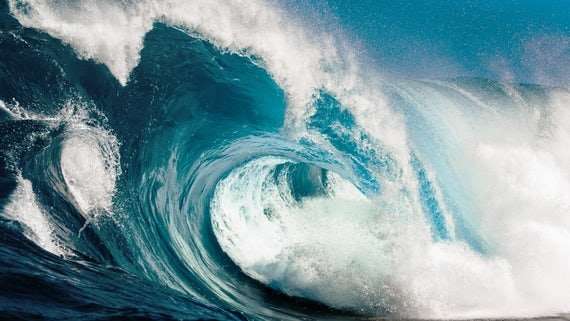Calculating tsunami's size and destructive force by exploiting high-speed acoustic gravity waves

Mathematicians have devised a way of calculating the size of a tsunami and its destructive force well in advance of it making landfall by measuring fast-moving underwater sound waves, opening up the possibility of a real-time early warning system.
The sound waves, known as acoustic gravity waves (AGWs), are naturally occurring and can be generated in the deep ocean after tsunami trigger events, such as underwater earthquakes.
They can travel over 10 times faster than tsunamis and spread out in all directions, regardless of the trajectory of the tsunami, making them easy to pick up using standard underwater hydrophones and an ideal source of information for early warning systems.
In a new study published in the Journal of Fluid Mechanics, scientists from Cardiff University have shown how the key characteristics of an earthquake, such as its location, duration, dimensions, orientation, and speed, can be determined when AGWs are detected by just a single hydrophone in the ocean.
More importantly, once the fault characteristics are found, calculating the tsunami amplitude and potential destructive force becomes more trivial, the researchers state.
Lead author of the study Dr. Usama Kadri, from Cardiff University's School of Mathematics, said: "By taking measurements of acoustic gravity waves, we basically have everything we need to set off a tsunami alarm."
Underwater earthquakes are triggered by the movement of tectonic plates on the ocean floor and are the main cause of tsunamis.
Tsunamis are currently detected via dart buoys – floating devices that are able to measure pressure changes in the ocean caused by tsunamis. However, the technology relies on a tsunami physically reaching the dart buoys, which could be problematic if the buoys are close to the shoreline.
The current technology also requires the distribution of a huge number of buoys in oceans all around the world, which is very costly.
"Though we can currently measure earthquakes using seismic sensors, these do not tell us if tsunamis are likely to follow," Dr. Kadri continued.
"Using sound signals in the water, we can identify the characteristics of the earthquakes fault, from which we can then calculate the characteristics of a tsunami. Since our solution is analytical, everything can be calculated in near real-time.
"Our aim is to be able to set off a tsunami alarm within a few minutes from recording the sound signals in a hydrophone station."
AGWs are naturally occurring sounds waves that move through the deep ocean at the speed of sound and can travel thousands of metres below the surface.
AGWs can measure tens or even hundreds of kilometres in length and it is thought that certain lifeforms such as plankton, that are unable to swim against a current, rely on the waves to aid their movement, enhancing their ability to find food.
More information: Ali Abdolali et al. On the propagation of acoustic–gravity waves under elastic ice sheets, Journal of Fluid Mechanics (2018). DOI: 10.1017/jfm.2017.808
Journal information: Journal of Fluid Mechanics
Provided by Cardiff University




















